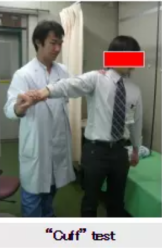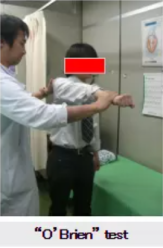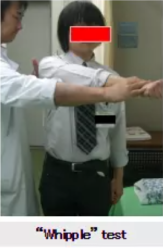Diseases in the Shoulder Joint Area①
The following are disorders commonly seen in the shoulder joint region.
肩関節周囲炎、拘縮:Adhesive capsulitis (frozen shoulder), shoulder contracture
腱板断裂:Rotator cuff tear
反復性肩関節前方不安定症:Recurrent anterior shoulder instability
石灰沈着性腱板炎:Calcific tendinitis of the rotator cuff
投球障害肩:Thrower's shoulder (または Overhead athlete's shoulder disorder)
非外傷性肩関節不安定症:Non-traumatic shoulder instability
Shoulder joint disorders and common chief complaints of outpatient visitors
・Pain
・Limited elevation and movement disorders
When exactly does the pain occur?
・Is the pain present at rest, that is, even when staying still?
・Does the pain occur during movement or activity?
It is very important to determine the intensity of the pain and when the pain occurs.
Clinical presentation of pain due to inflammation
・Pain at rest
・Pain with minimal movement
・ Severe pain
Treatment
- Rest and relaxation (instruction on how to relax the muscles)
- Steroid injections, hyaluronic acid injections
- Oral steroids
Steroids are effective drugs for reducing inflammation, but because they have strong side effects, their use is determined according to the presence of complications.
Clinical presentation other than pain due to inflammation
- No pain at rest
- Pain during movement
- Pain is present but manageable (can be controlled by the patient)
The next step is to perform a physical examination—that is, an assessment of shoulder movement.
My method of conducting the physical examination
Measurement of range of motion
(The shoulder joint has the greatest range of motion among all joints in the human body. We move the shoulder in various directions to determine in which directions pain or other symptoms occur.)

Physical Examination 2
Muscle strength assessment
(We measure in which directions the shoulder can generate force and in which directions weakness is present.)

The arm is abducted to 90 degrees in the scapular plane, and the examiner applies resistance. If there is weakness compared to the healthy side or the patient reports pain, the test is considered positive.

The arm is raised to 90 degrees in forward flexion, and the examiner applies resistance. If there is weakness compared to the healthy side or the patient reports pain, the test is considered positive.

The arm is elevated at 30 degrees of horizontal adduction in the scapular plane, and the examiner applies resistance. If there is weakness compared to the healthy side or the patient reports pain, the test is considered positive.
A preliminary evaluation is made up to this point.
・ Difference in range of motion between the affected and healthy sides
・ Whether there is weakness in any position
・ Presence or absence of impingement, etc.
・ Difference between affected and healthy sides → Is there a contracture?
・ Weakness in certain positions → Is there a dysfunction of the rotator cuff?
・ Presence or absence of impingement → Is scapular movement impaired? Or is it due to rotator cuff tear affecting movement?
Examination Process

Medical Interview → Physical Examination (Assessment of symptoms such as pain when moving the shoulder) → Management of Inflammation → Prescription of Physical Therapy → MRI and other tests → Surgery.
